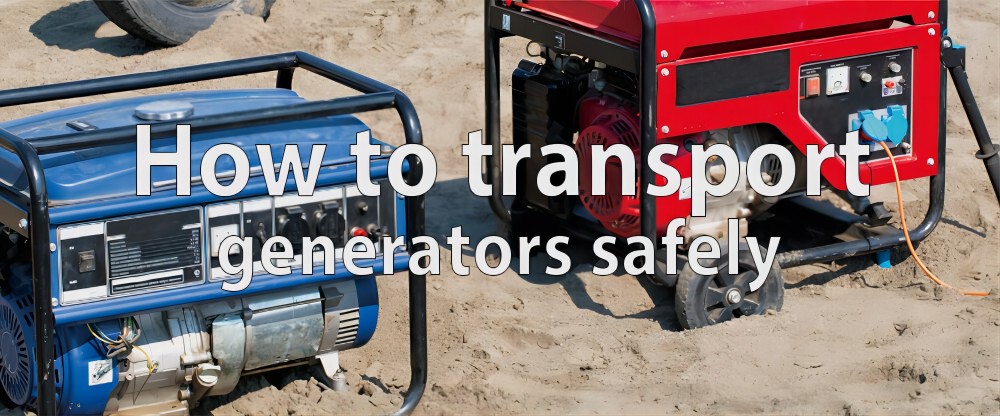24Feb 2023
table of contents

Regardless of whether it is a petrol generator or inverter generator, you've invested in a set of generators to enjoy power while you work or play. Before you can use your generator, you need to transport it safely and securely, using the following tips can help prevent accidents and prevent damage to your generator. For more tips or to import generators, visit the list of BISON generators.
How to transport generators safely?
Start by checking the owner's manual provided by generator manufacturer. Every generator is different, see if there are any unique tasks for your given generator model. You may or may not need to perform some steps, but it's helpful to know the steps below.
If the engine is running all the time, it will be very hot. If you have used the generator recently, please wait at least 20 minutes. Because the generator needs to be completely cooled before shipping to protect you from burns and damage to generator components.
Double check that the fuel valve is closed. Otherwise, fuel could get into the crankcase and dilute the oil during transport. NOTE: Before transporting a BISON portable generator, it is best to close the fuel valve when the engine is not running to prevent possible leaks into the crankcase.
Generators shall be built with designated handles. For example, the generators provided by BISON are all with handles, just use these!
Do not transport the generator on its side. Laying the generator on its side can cause fuel and oil leaks and damage other components. Make sure the vehicle used for transport allows the generator to move upright. For proper transport, the manufacturer of BISON recommends always using a truck or trailer.
Do not put the generator in the car, the fumes in the fuel tank may endanger the user's health. this
Vibrations while driving can cause the alternator to move. In this case, you will need to secure your BISON generator to the truck bed or trailer, taking this step will keep your generator and others safe. Otherwise, if not secured, bouncing or bumping during transport could damage the generator assembly, causing costly damage.
Stand the generator upright and secure with bungee cords or ties. Lock the wheels to prevent them from moving around while driving. Be sure to avoid placing something on top of the generator.
Pay attention to maintaining a constant speed while driving. Take turns changing lanes slowly and steadily. Allow enough space between you and other drivers to reduce the chance of slamming on the brakes, which could cause the generator to tip over.
In order to use your power generator, enough fuel is needed, so making sure your fuel gets to the work area is half the battle of transporting your generator. Models tend to run on propane, gasoline, or diesel, which are all potentially volatile liquids. Handle these with care! Start by securing the fuel tank cap and any vents in it. An open or unsecured lid could mean a spill or just smoke leaking. Afterwards, place the fuel can in the truck bed or car trunk. Avoid keeping it in the passenger compartment as even an empty container will leak remaining vapors. Secure the container upright so it cannot move around during transport. As a warning: don't leave fuel in the car for too long. Risks are possible escaping fumes and burn hazard. Remember to remove the fuel container immediately after use.
Always carry a leak kit with you to fix any fuel leaks or spills while in transit or while the generator is on site. This should include gloves, funnels for fuel dispensing and absorbent material to absorb any spills. When adding oil, place the drip pan under the alternator and its hoses.
If your generator has a built-in dike, make sure it's empty before moving the machine so it doesn't overflow. When using generators with dikes, make sure no holes are drilled.
Keep your generator away from standing water and cover it to keep it from getting wet when not in use. Do not leave it outside in inclement weather conditions.
Of course, here are some additional tips for safely transporting generators:
Check the weather, avoid transporting the machine in severe weather conditions such as strong winds, heavy rain or snow.
Token generator, label the machine with make, model and serial number. This is helpful if it gets lost or stolen in transit.
Make sure the generator, consider making sure your generator set is not damaged or lost in transit.
Planning route, plan your route ahead of time, taking into account any weight restrictions, road closures and other factors that may affect generator transportation.
Get help when you need it, If the generator set is too heavy to move by yourself, ask a friend or a professional mover for help.
Hopefully some of these tips help you and your generator get ready for your destination. If you are still looking for some generator tips, or you are interested in checking out the best generators, head over to BISON Generators, if you still have any questions, let our professional team answer all your questions and help you find what you want Wanted for something!
inquiry form here
BISON BLOG, All the latest news and views from Bison Machinery.